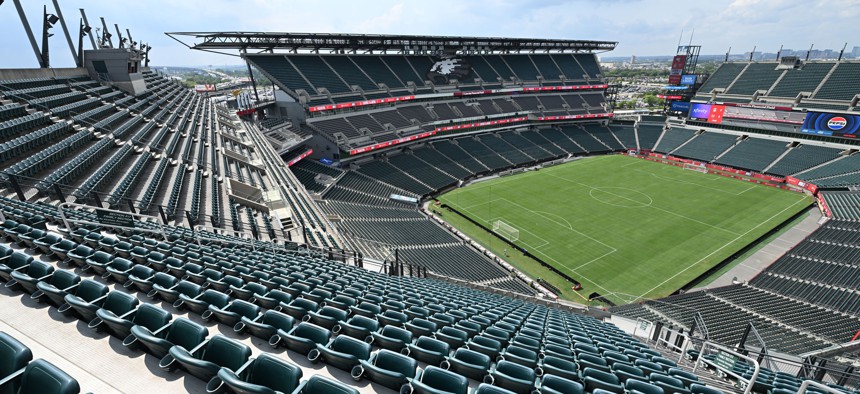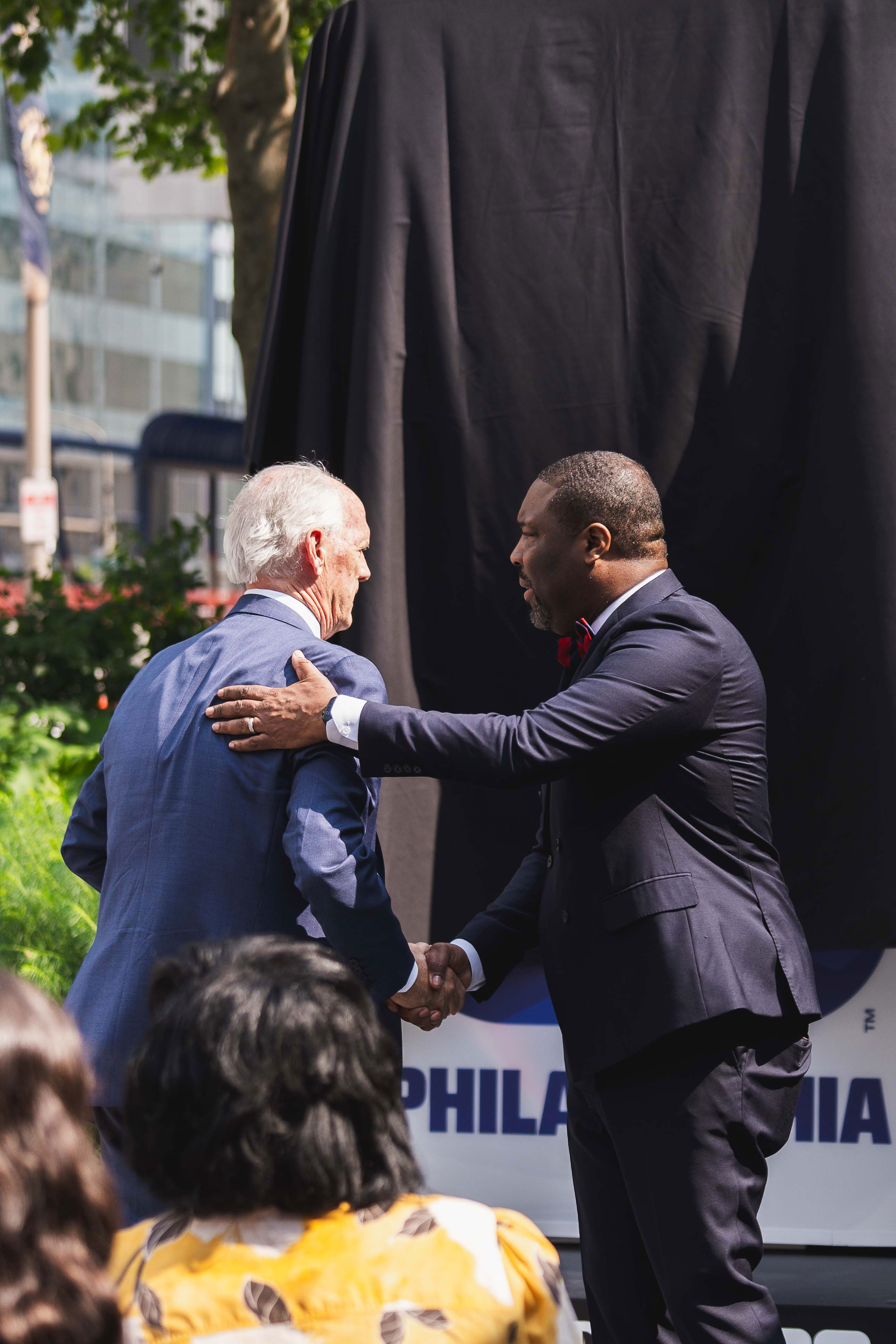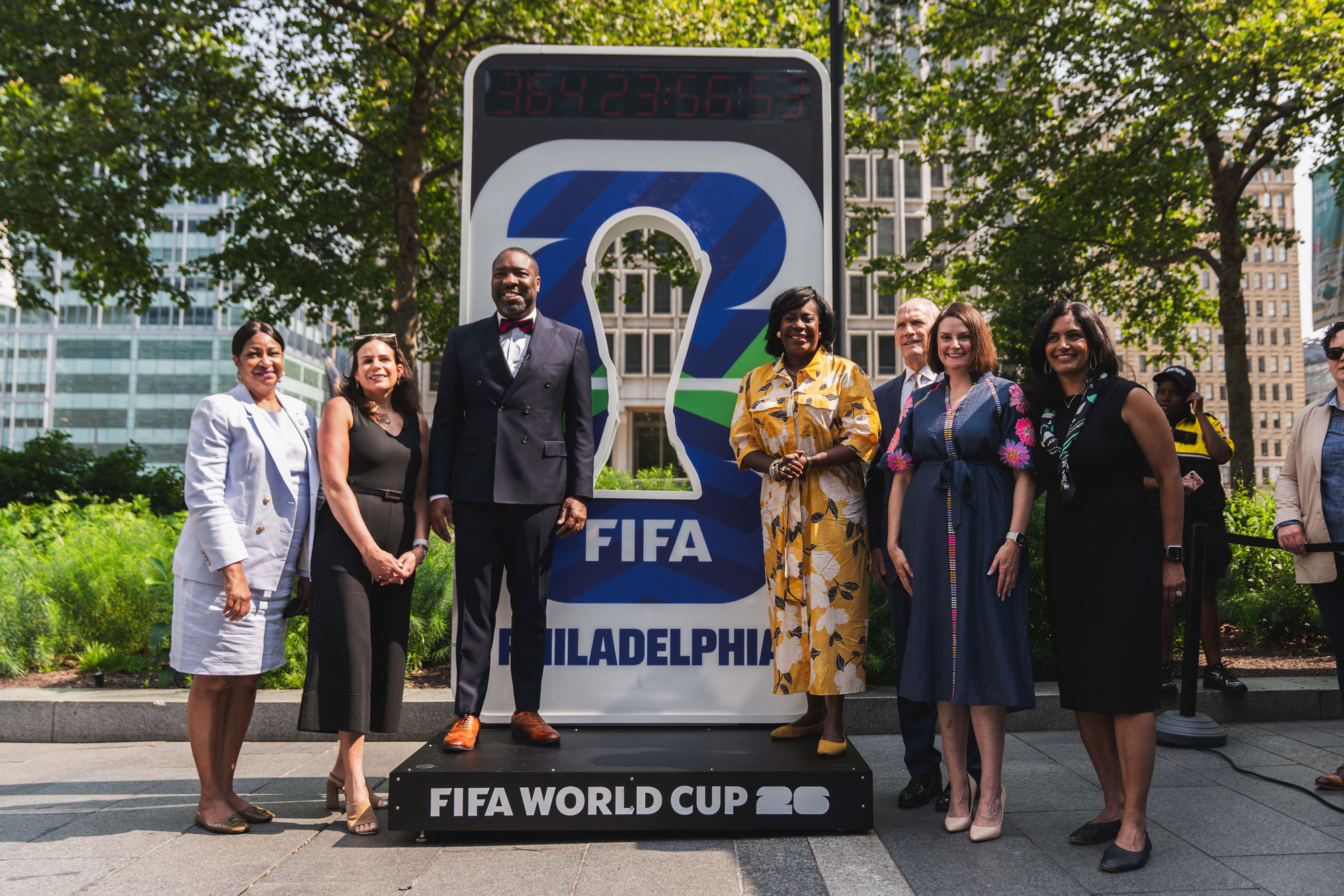Interviews & Profiles
Ask the Experts: Philly’s World Cup preparations
World Cup leaders and stakeholders from past world-class events share their lessons learned going into 2026

Lincoln Financial Field before a pre-season friendly between Arsenal and Liverpool on July 31, 2024 Stuart MacFarlane/Arsenal FC via Getty Images
As of June 11, when officials unveiled the countdown clock in Center City Philadelphia, time is ticking as the city prepares to be a host city for the 2026 FIFA World Cup. The month-long celebration of soccer, which includes five Group Stage matches and an elimination match on July 4 at Lincoln Financial Field, is expected to bring roughly half a million visitors to the region.
To learn about best practices and what Philadelphia needs to do before events kick off, City & State spoke with leaders in the World Cup and event-planning space, including Meg Kane, Philadelphia Soccer 2026’s host city executive; Zoe Baldwin, vice president of state programs and New Jersey director of the Regional Plan Association; and Bruce Seaman, emeritus economics professor at Georgia State University, Andrew Young School of Policy Studies.
The conversations have been edited for length and clarity.
How have previous international events, such as the papal visit more than a decade ago, shaped the World Cup preparations?
MK: When I think about the papal visit, there are three key lessons that I learned. First and foremost is making sure that the City of Philadelphia and its residents and the region do not feel as if this event is happening to it, but it is happening because of them – their passion and their authenticity.
The second lesson: appreciating what our neighborhoods, immigrant histories and culture have brought to our city and preparation, from the first wave of European immigrants who came and worked on the river wards in the factories and played soccer after work in the mid-1800s to those who have come from the Caribbean nations, from South America, from Africa. The expansion of the 2026 tournament from 32 to 48 nations is going to elevate even more nations – and better reflect that.
The last lesson is to be as ready to be nimble as possible. For any large event, there is this vision in my head, but the question is, does everything line up to allow that vision to come forth? And if not, have you created a plan that is nimble and flexible enough to be able to meet the needs of both the residents, tourists, and in this case, FIFA? We can have a plan that works perfectly for the opening match on June 14 … but if something happens or changes, do we have a plan that can be nimble enough to accommodate change between June 22 and June 25? Do we have the communication infrastructure to make sure that people understand the change?
Zoe Baldwin: Transportation was a massive problem when New Jersey hosted the Super Bowl due to the location of MetLife Stadium. However, the plans aren't yet fully clear regarding the transit and travel arrangements that will be available for the game in New York. It’s also a very different crowd, and you need to approach it that way. You can't just look at crowd size and compare it to a Beyoncé or Taylor Swift concert. It's massive, but the vast majority of people attending that event are somewhat local and probably American, whereas here you'll have visitors from all over the world, which means they won't be familiar with your transportation systems, whether it's transit or roadways. That's when you find out that your wayfinding signs are perhaps less than adequate for people for whom English is a second language. Wayfinding is a massive part of these kinds of games.
Are there any host cities from previous World Cups or Olympics that serve as models for how a city should approach a large event?
ZB: The big one is Barcelona when they hosted the Olympics in 1992. It’s different structurally because you’re housing all the athletes in a way that’s different from the World Cup, so they did have to build the Olympic Village and everything around it … This goes back to that double duty of, can we do something for the World Cup that’s also a lasting investment? You can still go to the Olympic Village in Barcelona. They started their process thinking, “We don’t want this to be the tale of the tissue paper house.”

Bruce Seaman: Every city wants to take advantage of this opportunity, certainly as Atlanta tried to do for the 1996 Summer Olympics. I believe the Olympics were successful for Atlanta as a catalyst for additional growth within the region. Trying to redirect some of the Olympics-driven attention and investment to revitalize Atlanta's downtown area was a key goal.
You have longer-term issues you’re dealing with in Philly, as does Atlanta, that may or may not be affected by this. And sometimes, there is a burden of hosting these things; there’s a negative aspect as well, but I think Philly is on the right track. FanFest activities are always big deals.
How can the World Cup reach all of the city, not just Center City and the stadium complex?
MK: We've thought about everything in a way that gives us a vision right for how this is all interconnected, how this is all complementary and not competitive.
We don't know the nations that are going to play a role in activating certain neighborhoods. For instance, if we draw a match with the Brazilian team, Northeast Philadelphia around Castor Avenue is going to be electric because of that community. We could get certain teams from Africa and have Africatown and the Baltimore Avenue corridor be electric. There’s a lot that is still to be determined, but we’ve always envisioned that our neighborhoods were going to play a significant role for Philadelphia in 2026.
ZB: New York’s structure, with several business improvement districts and special improvement districts, has those folks coordinating with each other, which is a really good start. How do they engage but not step on each other’s toes, and what resources are available for that engagement? This is an interesting time for people working in this field to realize that when discussing a large city like Philadelphia or New York, there is not only the central business district but also these mini-downtowns throughout the city. This is a great time for communities to access their regional planning authority about planning resources and placemaking resources. Some placemaking can be really simple – you might not have any benches, for example – things people might not be thinking about. This is an excellent time to look for those resources.
One thing the city and state should coordinate to help neighborhoods, depending on the community's structure, is implementing street closures. The city and state should make it as easy and as standardized as possible to help towns with planning and making sure there are as few bureaucratic hurdles as possible to help underresourced communities be able to use this as an anchor or unifying event.
BS: Visitors will be staying at hotels largely in Center City, right? There are some hotels in the metro area but some people will visit friends and family if they have connections. I think this international tourism is a wild card given the overt hostility increasing parts of the world population has toward visiting the United States … Places where people are staying and spending nights are going to have the most direct economic impact, but there will be indirect and induced impacts that will spread out with supply chains and spending flows.
FanFest in Lemon Hill is a logical step to take. The city must make sure that it’s accessible in a very convenient way so people who are staying nearby can get there. Many of these events, which were previously one- or two-day affairs, can now become week-long events, allowing for greater creativity in their execution.
How important is public transit for an event like this?
MK: In any major event that I've worked with, SEPTA has been operationally outstanding, and I have every expectation it will be for the FIFA World Cup as well. They are experts in how to move people.
Philadelphia Soccer 2026 is closely monitoring SEPTA’s funding situation and we will be nimble based upon what the outcome of these negotiations are. We certainly want SEPTA to be an essential part of our transportation mobility planning.
ZB: SEPTA is a really important part of your system, and just being aware of how that factors into your broader circulation plans is really important. One of the things you have to realize is that it is actually very non-traditional. Most games in the past have been held at stadiums that are not downtown, but very accessible by transit, and that's what many soccer fans are accustomed to. There's a huge culture of walking to soccer games where you get a large crowd of people walking with their scarves and their regalia. It's going to be a challenge for any of the host cities in the US to ensure that they're moving as many people through transit as possible; making sure that you distribute that surge across a network is really important.

BS: The most important thing that cities have control over is just facilitating transportation within the events … Philadelphia obviously is not as walkable as (other cities), but it is walkable. Atlanta’s system is terrific in terms of airport-to-downtown connections. That is a clear strength … This has been an issue with Philadelphia and the sports teams being in South Philly. The subway in Philly isn’t overly attractive, but it can be and it does go places.
Transportation from Center City to the sports venues will be absolutely critical. With state and federal funds up in the air, it puts Philly in a bit of a jam … If you’re talking about more tourism-friendly parts of the city, near Center City, most people who are visiting the city are not going to hop on the subway. For an event like the World Cup, you have to enhance access in an easy and entertaining way, frankly. It can’t be a burden for these people to get to the facilities.
NEXT STORY: This week’s biggest Winners & Losers
